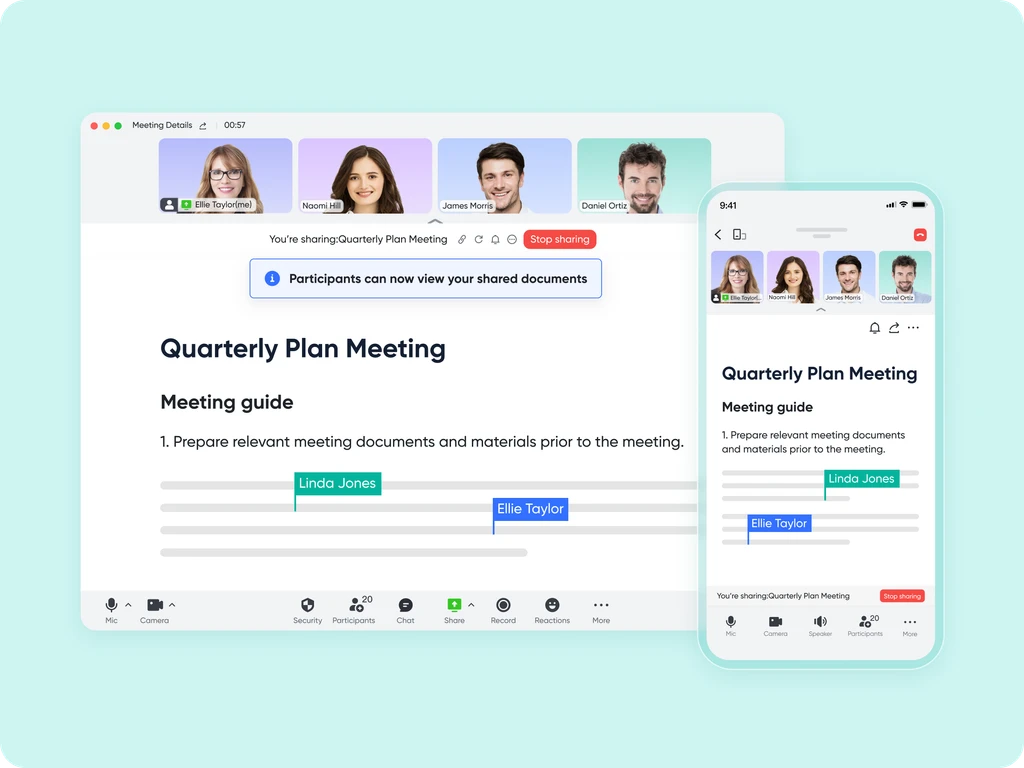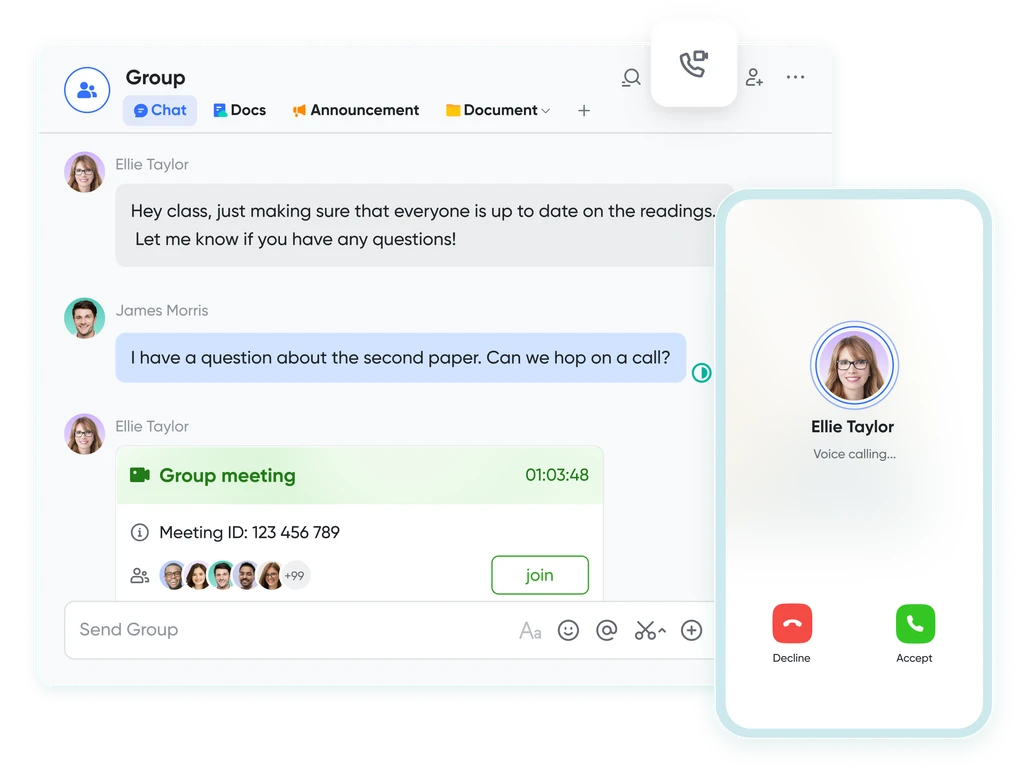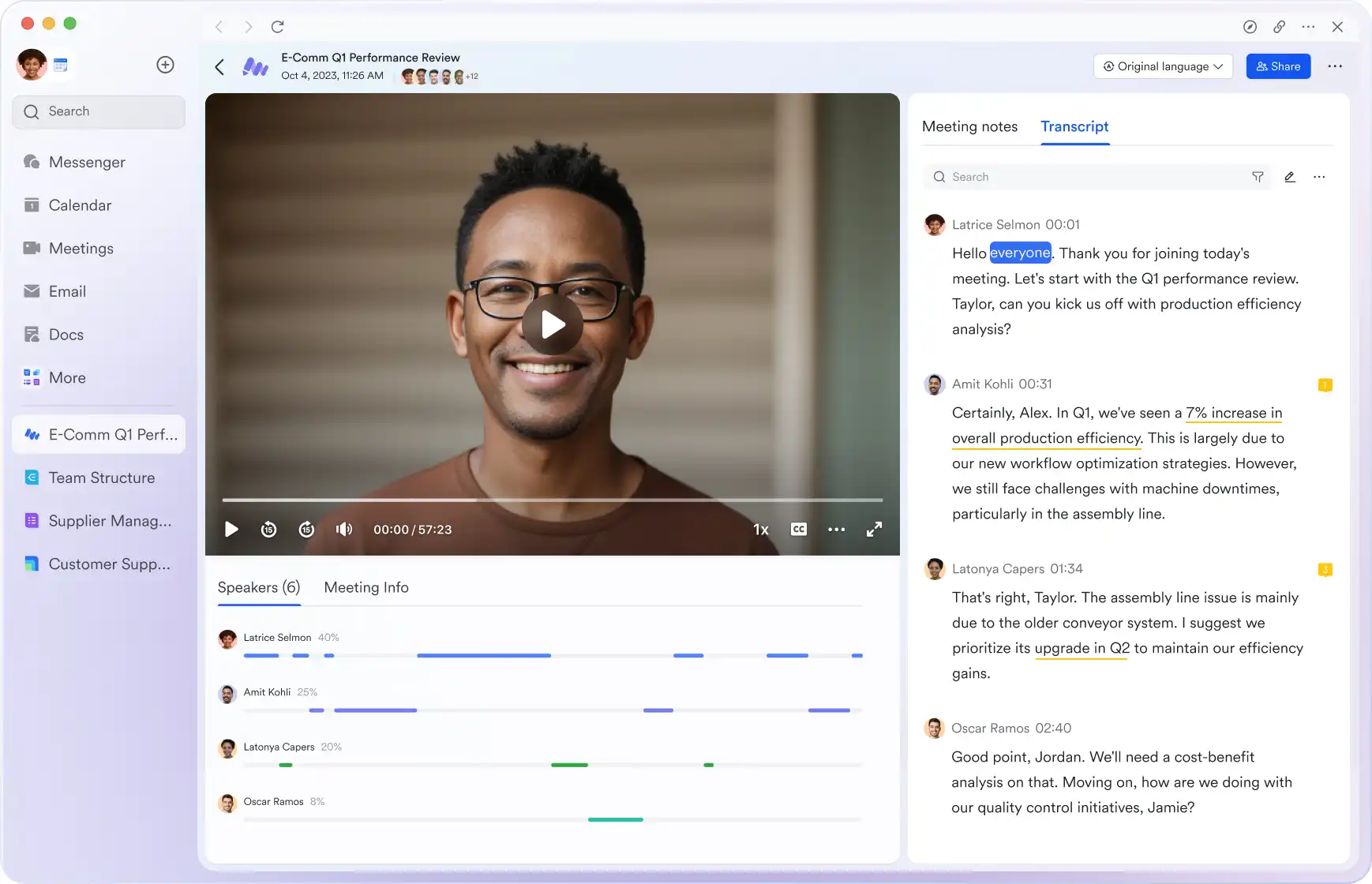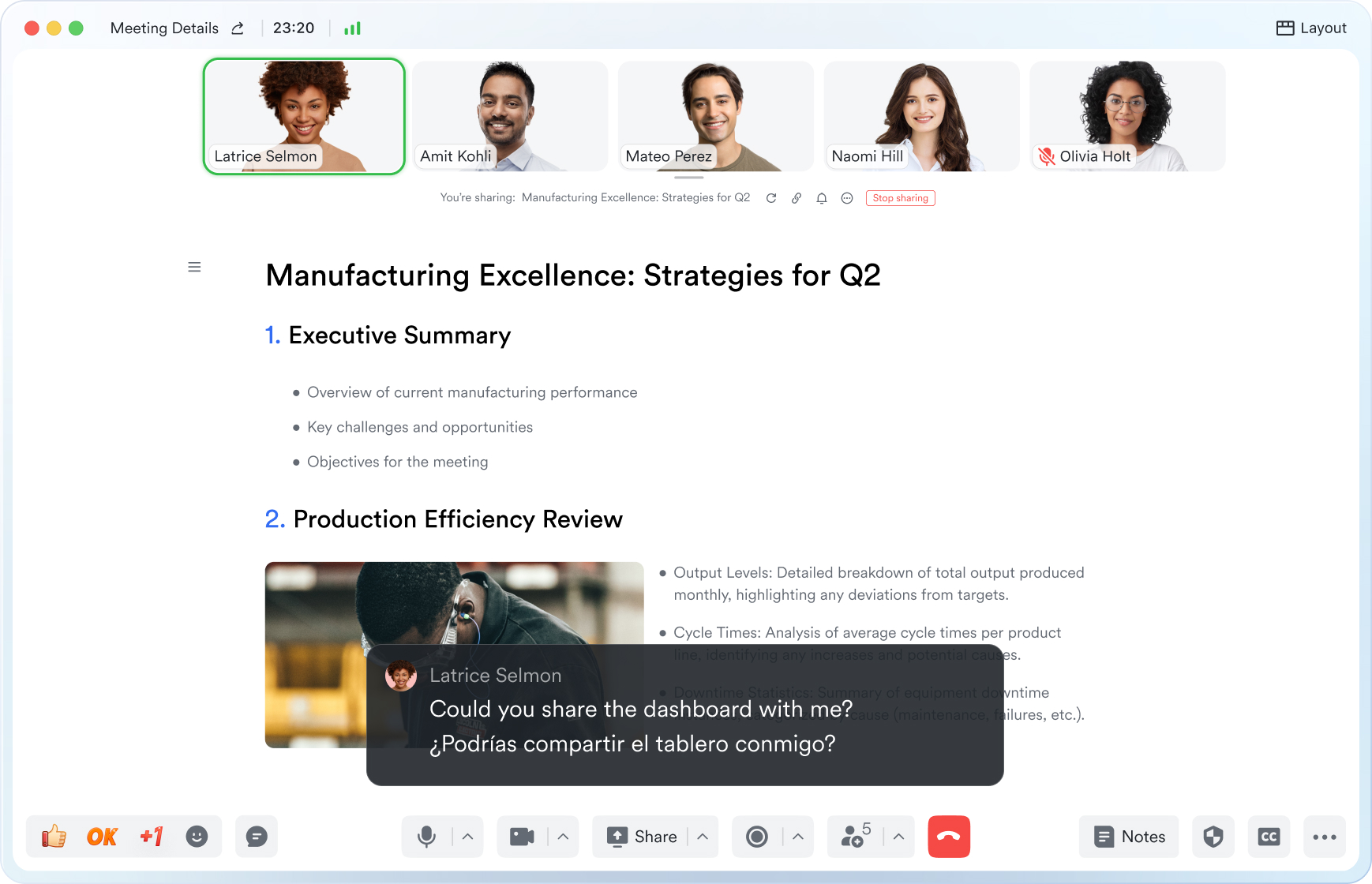Monthly Review Meeting
This guide will walk you through the essential elements of use monthly review meeting to keep your attendees aligned and engaged.
Try Lark for Free
In today’s fast-paced corporate environment, hosting effective monthly review meetings has become a critical component for driving organizational success. Mastering the art of conducting these meetings enables businesses to align objectives, monitor performance, and foster continuous improvement. This comprehensive guide provides insights into the best practices for hosting successful monthly review sessions, ensuring that they serve as powerful tools for driving growth and success in 2024.
Use Lark Meetings to turn meetings into true collaborative experiences.
What is a monthly review meeting?
A monthly review meeting is a structured gathering aimed at evaluating the progress, accomplishments, and challenges encountered by a team or department within an organization over a specified period, typically a month. This type of meeting serves as a platform for teams to review past performance, set new goals, and make strategic decisions. In 2024, monthly review meetings are crucial for fostering a culture of accountability, collaboration, and continuous improvement within organizations.
Goals of monthly review meetings
The primary goals of monthly review meetings include:
- Aligning team members with organizational objectives and key results (OKRs).
- Monitoring progress towards predefined targets and KPIs.
- Identifying and addressing any obstacles hindering performance.
- Establishing a forum for open communication, constructive feedback, and knowledge sharing.
Who should attend monthly review meetings?
Attendance at monthly review meetings should encompass:
- Key stakeholders, including senior executives and department heads.
- Team leads and project managers responsible for delivering on key objectives.
- Cross-functional representatives to ensure comprehensive insights and effective decision-making.
Learn more about Lark x Meetings
Topics, agenda, and structure of monthly review meetings
To ensure the effectiveness of monthly review meetings, the following aspects should be considered:
- Agenda Composition: Structuring the agenda to accommodate necessary topics such as performance review, goal setting, and issue resolution.
- Time Allocation: Allocating time for each agenda item based on its importance and relevance.
- Meeting Flow: Creating a balanced meeting flow to facilitate productive discussions and decision-making.
Related:
Unlock the Power of Webinars: A Comprehensive Guide to Boost Your Business | Lark Blog | Lark BlogLearn more about Lark x Meetings
How often does a monthly review meeting occur?
Monthly review meetings are conducted on a monthly basis, typically at the end or beginning of each month. The monthly frequency ensures that teams can review performance, reset objectives, and make necessary adjustments to their strategies. However, based on organizational needs and dynamics, the frequency of these meetings may be modified. Alternative frequencies, such as bi-monthly or quarterly reviews, are also viable options, allowing for more comprehensive assessments of long-term objectives, albeit with potential trade-offs in timely decision-making.
Key differences between monthly review meetings and another similar meetings
Distinctive characteristics that set monthly review meetings apart from other similar meetings include:
- Purpose and Focus: Monthly review meetings are specifically designed for evaluating past performance, setting new goals, and reviewing the progress of projects or teams over a month.
- Frequency: These meetings occur monthly, providing regular checkpoints for performance evaluation and strategic realignment.
Learn more about Lark x Meetings
Three practical examples of monthly review meetings
Example 1: agile sprint review
Example 1: agile sprint review
In a software development environment practicing Agile methodologies, monthly review meetings, often referred to as sprint reviews, are conducted to assess the progress of each development sprint.
Meeting Structure:
-
Demonstration of completed work
-
Team collaboration on challenges and areas for improvement
-
Iterative feedback and adaptation of plans based on review outcomes
Example 2: marketing campaign performance review
Example 2: marketing campaign performance review
In the marketing domain, a monthly review meeting may involve a comprehensive analysis of the performance of ongoing marketing campaigns.
Meeting Focus:
-
Evaluation of campaign outcomes against predefined KPIs
-
Identification of successful strategies and areas requiring optimization
-
Realignment of the marketing strategy based on the review discussions
Example 3: sales team performance evaluation
Example 3: sales team performance evaluation
Monthly review meetings in the context of sales operations focus on assessing the performance of sales teams, analyzing key metrics, and devising strategies for achieving sales targets.
Discussion Points:
-
Review of sales figures and pipeline status
-
Identification of successful sales strategies and areas for improvement
-
Formulation of new sales targets and action plans
Common pitfalls of monthly review meetings
The following common pitfalls are detrimental to the effectiveness of monthly review meetings:
- Lack of Clear Objectives: When the purpose and expected outcomes of the meeting are not clearly defined, it can lead to unfocused discussions and inconclusive decisions.
- Inefficient Time Management: Poorly allocated time may result in rushed discussions or incomplete coverage of agenda items.
- Limited Participation and Engagement: If all attendees do not actively participate, valuable insights and perspectives may be missed, impacting the quality of decisions made.
- Inadequate Follow-up: Without proper documentation and follow-up, action items and decisions may be forgotten or overlooked.
Learn more about Lark x Meetings
Dos and don'ts of monthly review meetings
The success of monthly review meetings is greatly influenced by adhering to certain dos and avoiding common pitfalls.
| Do's | Don'ts |
|---|---|
| Encourage open communication | Make it a monologue |
| Prepare and distribute agenda in advance | Overfill the agenda |
| Summarize action items and next steps | Avoid follow-up after the meeting |
| Focus on data-driven discussions | Neglect key performance indicators |
| Allow for constructive debate and dialogue | Encourage conflict without resolution |
What makes a virtual monthly review meeting successful?
In the ever-evolving landscape of virtual collaboration, the success of virtual monthly review meetings hinges on certain factors, including:
- Seamless Technology Integration: Utilization of advanced virtual meeting platforms offering features such as breakout rooms, real-time collaboration, and interactive tools for effective remote engagement.
- Active Participation: Encouraging participation through interactive polls, Q&A sessions, and virtual whiteboards.
- Overcoming Challenges: Implementing strategies to overcome the challenges associated with virtual interactions, such as maintaining engagement and managing distractions in a remote setting.
Learn more about Lark x Meetings
Typical takeaways of monthly review meetings
After a successful monthly review meeting, the following outcomes are expected:
- Clear Action Items: Defined action items and responsibilities to address identified challenges and capitalize on opportunities.
- Agreed-upon Strategies: Aligned strategies and plans for the upcoming period based on the evaluation of the current month’s performance.
- Enhanced Collaboration: Improved collaborative efforts and a shared understanding of collective goals and objectives.
Questions to ask in monthly review meetings
Asking the right questions serves as a catalyst for productive discussions and decisions in monthly review meetings. Some effective questions to pose include:
- “What were the key achievements against our monthly targets?”
- “Are there any roadblocks or challenges hindering our progress?”
- “What are the areas that require additional support or resources to enhance performance?”
Related:
Master the Art of Meeting Notes with Lark for Enhanced Collaboration | Lark Blog | Lark BlogLearn more about Lark x Meetings
Conclusion
In conclusion, hosting successful monthly review meetings plays a pivotal role in shaping the performance and strategic direction of an organization. By adhering to best practices, actively involving crucial stakeholders, and leveraging the potential of these meetings, organizations can ensure continuous improvement and sustained success.
Use Lark Meetings to turn meetings into true collaborative experiences.
A Game Changer for Monthly Review Meeting: Empower your team with Lark Meetings
In the fast-paced and dynamic world of modern business, effective communication and collaboration are crucial for success of Monthly Review Meeting. Here we introduce Lark Meetings to serve as a centralized hub for all communication needs.
Transform your meetings into collaborative endeavors

Leverage the potency of in-call document sharing, intelligent meeting minutes, and mobile-optimized features to enhance productivity collaboratively, irrespective of your location or schedule.
Seamlessly collaborate in real-time, across any device

Share live documents instead of just screen views. Participants can navigate and edit simultaneously within the video call window, even while on the move.
Shift your focus to engagement, not note-taking

Lark Minutes automatically converts video meetings into transcripts, facilitating easy viewing, searching, and collaborative editing. Stay in the loop asynchronously, even if you can't attend the live meeting. Lark Minutes for meeting minutes support translation into 10+ different languages.
Break language barriers in communication

Lark Meetings provide real-time translation for subtitles, allowing individuals from diverse backgrounds to express themselves in their native languages. Ensure every voice is heard, regardless of geographical location. Live subtitles currently support translations from English, Chinese, and Japanese to 10+ different languages. See more translation feature in Lark.
Connect with larger audiences
Host dynamic online meetings and events accommodating up to 1,000 participants, with the flexibility of up to 50 breakout sessions for intimate group discussions within the larger meeting context. Try more Lark features for free.








